The following report is a complimentary offering from MEMRI’s Jihad and Terrorism Threat Monitor (JTTM). For JTTM subscription information, click here.
MEMRI: On February 24, 2016, a letter from an Islamic State (ISIS) fighter to ISIS leader Abu Bakr Al-Baghdadi was posted on social media. In it, the fighter strongly protests the close ties and cooperation between ISIS’s Sinai province and Hamas, particularly Hamas’s military wing.
This letter is the first confirmation of ties between the two organizations that comes from ISIS itself, and a unique firsthand account of the nature of these ties. It appears that the document was not meant for circulation outside ISIS, and to have been leaked by Al-Qaeda supporters.[1]
The letter is by ISIS fighter Abu ‘Abdallah Al-Muhajir, who presents himself as a Gazan who joined ISIS in Syria. He writes that he decided to appeal to Al-Baghdadi in order to fulfill his duty as a Muslim to give loyal advice to the leader of the Muslims. His letter is based on his own personal knowledge from his time in Gaza, as well as on information provided to him by other fighters who came to Syria from the Gaza Strip.
With regard to the ties between Hamas and ISIS’s Sinai Province, Abu ‘Abdallah explains the areas in which the groups collaborate: ISIS fighters in Sinai are smuggling weapons into Gaza for Hamas; Hamas is producing weapons and explosive devices for ISIS Sinai; Hamas is providing logistical assistance to ISIS Sinai, including communications systems and hospitalization for its wounded fighters in Gaza; and ISIS Sinai officials are visiting Gaza and dining at the homes of Hamas government and military wing officials.
Abu ‘Abdallah says that he considers these Hamas-ISIS Sinai ties a violation of the principle of loyalty to the Muslims and rejection of non-Muslims (Al-Walaa Wal-Baraa), stating ISIS considers Hamas a movement that has betrayed Islam and that as such there is no justification, even on the pretext of tactical, operational, and logistical necessity, for maintaining ties with it.
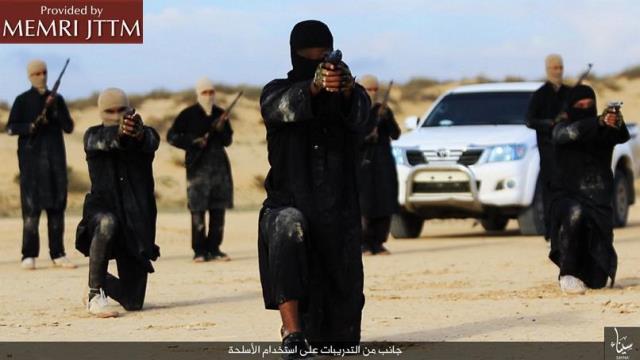
ISIS Sinai province displaying weapons training. Source: Telegram.me/HaiAlaElJehad5, February 6, 2016.
Noting that what motivated him to take the unusual step of writing directly to Al-Baghdadi was the rising rage and frustration among ISIS supporters in Gaza who feel abandoned by the ISIS leadership and by ISIS Sinai, Abu ‘Abdallah expresses harsh criticism of ISIS Sinai for its warm relationship with Hamas. Hamas, he says, is persecuting and torturing ISIS loyalists, and adds that the disconnect between ISIS supporters in Gaza and ISIS Sinai itself is so great that the Gaza jihadis are now questioning the sincerity of ISIS Sinai’s loyalty to ISIS itself and are hesitant to join with it.
Abu ‘Abdallah’s letter caused a stir among ISIS supporters, particularly in Gaza, both because of its content and because such a direct appeal to ISIS leader Al-Baghdadi had been posted online. A group of pro-ISIS media activists in Gaza, Al-Nusra Al-Maqdisiya, which publishes and disseminates pro-ISIS materials on social media. responded to the letter’s publication; however, it denied neither Abu ‘Abdallah’s claims in the letter, nor the details he gave about the Hamas-ISIS Sinai relationship. It was merely enraged because he mentioned the group his the letter.
Following are excerpts from the letter:
Abu ‘Abdallah: If ISIS Sinai Maintains Its Ties With Hamas “We Will All Regret The Disaster That Will Befall Us In Sinai”
Abu ‘Abdallah begins his letter by explaining that what ISIS Sinai is doing in its ties with Hamas is serious and could lead to disaster: “A complaint by a soldier in the [Islamic] State to the Caliph of the Muslims, against the actions of the brothers in Sinai Province. An urgent letter from Abu ‘Abdallah Al-Muhajir to our commander and Caliph of the Muslims Abu Bakr Al-Baghdadi, may Allah protect him.
“The Prophet said: ‘The religion is sincere advice’… which is why I seek Allah’s aid in writing and disseminating this urgent and highly important letter, which has in it serious matters that must be addressed, and ended, by Sheikh Abu Bakr Al-Baghdadi and the Islamic State leaders. For by Allah, if these things continue and persist, we will all regret the disaster [that will befall] us in the beloved land of Sinai, which is the most important and powerful [Islamic] State province outside Iraq and Syria.
“This is a letter from your son Abu ‘Abdallah Al-Muhajir, and in it are matters that I have experienced during my presence on Gaza soil, as well as matters about which the brothers [in Gaza] wrote to me after I joined [the fight] in Syria, and matters that I learned from brothers who emigrated to Syria and Iraq before I did. I recoiled from writing [the letter], and consulted with my immigrant brothers, and we agreed to publicize what we know, while the brothers in Gaza advised me to say these things secretly and not write publicly for fear of the response of the brothers in Sinai province. But matters have reached a point where it is no longer possible to remain silent, and providing advice in secret would not have helped. Silence in the face of what is happening would have made us the devils of silence, and silence is betrayal of Allah, His messenger, and the Caliph of the Muslims.
“Oh, Caliph of the Muslims, I wish to speak to you about an issue related to the foundations of the religion and the tenets of the faith – Al-Walaa Wal-Baraa [loyalty to Muslims and rejection of non-Muslims], for which the blood of thousands of Islamic State jihad fighters has been spilled. For the sake of this principle, we are hostile towards the entire world, we are withstanding a war waged against us by the whole world, and even by some who claim to be jihad fighters.
“[But] even after all these great sacrifices, some brothers come along and destroy [the principle of] Al-Walaa Wal-Baraa, on weak pretexts and for reasons unbecoming of any jihad fighter who belongs to this mighty state.
“I speak to you today about the suspect and illegitimate ties between Sinai province and Hamas, which are hidden from no one. What I will write about now is based on two main things:
“1. After a period of being in Syria, I have learned that the Islamic State considers Hamas, with all its branches and wings, to be an apostate movement, and that it treats it as an apostate cult, including [the ‘Izz Al-Din] Al-Qassam [Brigades, Hamas’s military wing]. This is known to all the brothers here in Syria and Iraq.
“2. The second thing is the internal memos coming from the [Islamic] State leadership ruling that many factions in Syria are apostates, including for collaborating with apostates and for transferring weapons to them or maintaining a relationship with them.”
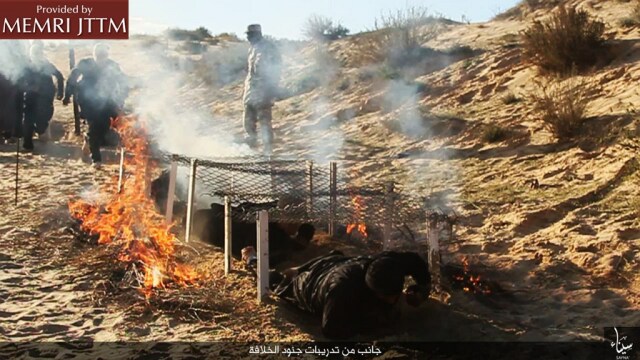
ISIS Sinai province fighters undergoing military training. Source: Telegram.me/HaiAlaElJehad5, February 6, 2016.
“Sinai Province Is Smuggling Weapons For Hamas In Gaza”
Abu ‘Abdallah then explains the ties between ISIS Sinai and Hamas, and tells why he thinks they are a violation of the tenets of loyalty:
“Allow me, Caliph of Muslims, to inform you of some aspects of the suspect ties between Sinai province and Hamas:
“1. Sinai province is smuggling weapons for Hamas in Gaza, because of the province’s fighters’ expert knowledge of the [smuggling] routes from Libya, Sudan, and Egypt.
“2. Sinai province depends very much on Hamas and Al-Qassam for weapons and for explosives and ammunition. There are direct and continuous supply routes from Hamas to Sinai province. The Al-Qassam factories operate assembly lines for manufacturing explosive devices and bombs for the Sinai province, but do not stamp the Al-Qassam logo on them, as they usually do.
“3. Sinai province leaders are regularly visiting the Gaza Strip, and holding cordial meetings with Hamas and Al-Qassam leaders, even [Hamas] government [representatives]. Animals are slaughtered for them, feasts are held, and they are embraced in Gaza.
“4. Hamas and Al-Qassam are accepting all wounded Sinai province [fighters], and they are treated in Gaza Strip hospitals under Al-Qassam’s direct protection.
“5. Hamas is providing wireless communication hubs for Sinai province, because of the difficulty of operating them in Sinai and because they are vulnerable to swift destruction by the Egyptian army.
“[Hypothetically,] if we disregard the religious dimension, and Al-Walaa Wal-Baraa, we would be able to say that Sinai province benefits greatly from these ties, and that the province is being clever and devious in order to attain power and ammo from Hamas, for fighting the infidel [Egyptian President] Al-Sisi. However, in truth, and viewing things on a shari’a level, the province is committing several religious transgressions… among them:
“1. Violating the principle of loyalty to jihad fighters in Gaza and Islamic State supporters [there], and abandoning them and handing them over to their apostate enemy (Hamas)…
“2. Violating the principle of rejecting Hamas, which has replaced the laws of Allah and rules Gaza with laws of unbelief, and of [rejecting] the Al-Qassam Brigades, [which is] this government’s violent aggressive force. I was shocked when I discovered here in Syria that the Islamic State treats the Hamas government and movement, and the Al-Qassam Brigades, as apostates. Where, then, does Sinai province stand on this?
“3. Strengthening the apostates and making it easier for weapons to reach them by smuggling weapons to Hamas via Sinai province land, even using the province’s men and vehicles. One of the brothers told me, by means of his brother who is in the [Gaza] Strip, that Israel bombed one of these convoys, killing province jihad fighters as they were transporting weapons to Hamas.
“4. Maintaining friendly ties with the leadership of Hamas and Al-Qassam, which the [Islamic] State considers apostates. [These ties include] exchanging visits with them, welcoming them, and treating them in a manner displeasing to Allah…
“5. Relying on Hamas and Al-Qassam – which the [Islamic] State consider apostates – for its supply of ammunition and weapons. This is no different than taking weapons from the UAE, Saudi Arabia, or Qatar in order to fight [Syrian President] Bashar Al-Assad, as the apostate factions do here in Syria, or as Hamas does when it takes money from Iran. [This action by Hamas] is a crime for which we have condemned Hamas for decades, and have ruled that it is apostate, for this and other reasons.
“Sinai Province Is A Pawn Of Hamas”
“Oh, Sheikh Abu Bakr, Sinai province thinks its actions are wise and that it is making a laughingstock of Hamas. But what the province leadership does not know, or what it is ignoring, is that Hamas is giving them these weapons so that they will use them against [Egyptian President] Al-Sisi, in an attempt to end his regime and in preparation for restoring the democratic rule of the Muslim Brotherhood.[2] [Sinai province] is a pawn of Hamas, which is being exploited as part of its Ikhwani [Muslim Brotherhood] plan. Were this not the case, Hamas would not have fought against Islamic State supporters in Gaza, and against anything related to the Islamic State.
“Oh sheikh of ours: Hamas is clever and is giving Sinai province everything it wants, so that it [Hamas] can gain a foothold in [Sinai], and so that it will have ‘stock’ in the province, and so that it will be able to protect itself against anything the province might do against it. They [Hamas’ leaders] are clever, oh sheikh – they give table scraps to the province, so that they can divide the men of tawhid [Islamic monotheism – nickname for Salafi-jihadis] and deal with them as they please, since no one supports them. Hamas knows that no one but Sinai province can help the Salafis in Gaza, and has therefore taken possession of it, and has thus kept it away from the crimes being carried out in Gaza against the supporters of the Islamic State.
“Oh, sheikh of ours and Caliph of the Muslims: If anyone tries to describe this situation to you in a way that contradicts this, then [know] that I am a loyal advisor. The relationship between Sinai province and Hamas has crossed all limits, and has reached the point where the province is asking Hamas to manufacture the uniforms for its soldiers. Hamas manufactures the military uniforms for Sinai province – the uniforms we see, and over which we rejoice, in videos are from Hamas, oh our Sheikh Abu Bakr. I swear to the Lord of the Ka’ba that it would have been better for the Sinai province soldiers to wear ragged, torn, and patched uniforms than to ask Hamas to manufacture their uniforms for them.
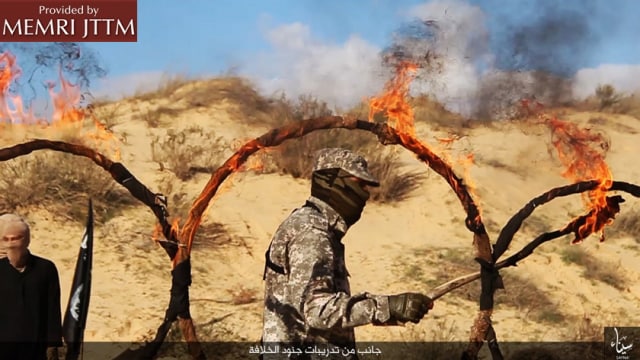
ISIS military trainer training Sinai province recruits
“In accordance with the close relationship between the sides, we find that for the sake of worldly honor which Hamas gives it, the Sinai province has sold its religion. This is embodied by Sinai province’s disregard of the cruel war that Hamas is waging against the supporters of the Islamic State. Sinai province does not even [dare] threaten, or warn Hamas, over its ongoing abuse of Islamic State supporters…
“The Hearts Of Islamic State Supporters In Gaza Are Filled With Rage And Shock At The Actions Of Sinai Province”
“Back when I visited the brothers in Rafah, they told me that Hamas men call Sinai province ‘the Raed Al-‘Atar Province’ – named after the Al-Qassam Brigades commander who oversaw the weapons and ammo shipments to the province.[3] One of the immigrant brothers [i.e. fighters from Gaza who came to Syria] told me, on behalf of brothers in Gaza, that one senior official in the apostate Hamas internal security [apparatus] would torture and ridicule Salafi jihad fighters, saying, ‘Our relations, in Hamas, with Sinai province are stronger and better than yours with Sinai province.”
“This is true and very real. Hamas and Sinai province are maintaining warm relations and direct lines of communication around the clock.. I know that Sinai province has severed ties with all the Salafi jihad fighters in the Gaza Strip, and is attempting to cut anything connecting it to them, so as not to sour the relations with Hamas and ruin the relationship between them. You must know, oh sheikh of ours, that Sinai province refrains from announcing the deaths of brothers that came to it from Gaza. They only announce their deaths much later, and claim that they were killed in other regions, not Sinai, so as not to embarrass Hamas, which is worried by this possibility.
“You must know that the jihad fighters ‘Abd Al-Rahman Al-Nouri[4] and ‘Arafat Al-Sa’idi[5] were killed in Sinai, but it was announced that they had died in Syria, which is not true. Additionally, one of the immigrant brothers in Sinai who came to Syria informed us of the death of a man named ‘Abd Al-Ilah Qashta, several months ago, but Sinai province has not yet announced his death, nor will it. The announcement of his death will be made by another province, because he was an Al-Qassam commander.[6]
“Some say that there is an agreement that the province will not accept anyone from Al-Qassam into its ranks, and that if one such man is killed, they will not announce his death. A few days ago, the death of Muflih Abu ‘Adhira was announced by [ISIS] Tripoli province [in Libya], even though he died in Sinai.[7]
All those mentioned above are jihad fighters from Gaza who immigrated to Sinai.
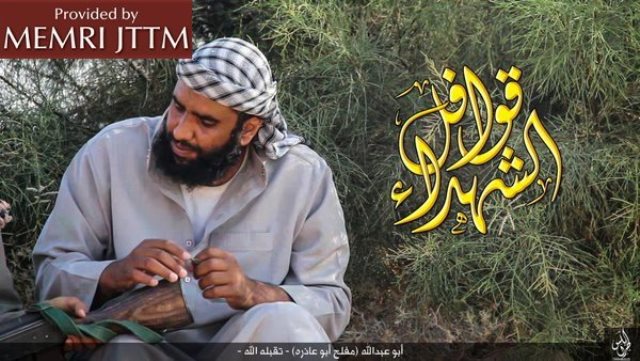
Poster of Muflih Abu ‘Adhira released by ISIS’s Tripoli province
“One of the brothers who recently came from Gaza to Syria said that the hearts of Islamic State supporters in Gaza are filled with rage and shock at the actions of Sinai province. For example, how can they accept that one of the province leaders is in the lap of Hamas luxury in Gaza, doing as he pleases and travelling to the homes of Hamas and Al-Qassam leaders, and enjoying their food at lavish banquets, while a few hundred meters away, Islamic State supporters are tortured in Hamas prisons, and their faces spat in, and are humiliated in in the worst way because of their loyalty and support for the Islamic State – of which Sinai is one of its most important provinces.
“I should mention here that Sinai province appointed a cleric to solve the problem of Salafi groups in the Gaza Strip. We were surprised when the cleric came to us and announced that the judge appointed by Sinai province had dismantled our organization, Majlis Shura Al-Mujahideen, which was the largest Salafi organization in the Gaza Strip.[8] He said to everyone: ‘Do not establish organizations [separately from the Islamic State] – go swear fealty to Sinai province.’ Some time later I asked the brothers [i.e. other Salafis in the Gaza Strip] what had happened [i.e., did the Sinai province accept their oath of fealty and bring them into its ranks]. They told me that the province was not responding to them. That is how things stayed until the end of my time in Gaza. There is no strength or ability other than Allah’s! Is this [a path that befits] the religion, oh our Sheikh Abu Bakr? [How can] the province dismantle the jihad groups who were operating for the sake of Allah’s religion [in Gaza] and then prevent them from joining it? …”
“One Last Thing For Sheikh Abu Bakr Al-Baghdadi: Do Not Forget The Supporters Of The Islamic State In Gaza”
“One last thing for Sheikh Abu Bakr Al-Baghdadi: Do not forget the supporters of the Islamic State in Gaza. Do not forget them, oh sheikh, for they were the first to support the [Islamic] state. They established [the pro-ISIS media activist group] Al-Nusra Al-Maqdisiya at a time when it was difficult to support the [Islamic] State, and it was under onslaught from all sides. The brothers we left behind in Gaza are a responsibility placed in your hands, oh Sheikh Abu Bakr; they are orphans at the tables of misers. Other than Allah, they have no supporters but the Islamic State.
“How can it be that while all [other ISIS] provinces conduct media campaigns [and release] videos to call jihad fighters in the Islamic Maghreb [North Africa], Somalia, Afghanistan, and Yemen to swear fealty to the Islamic State,[9] the letters, cries, and calls for help by the men of tawhid in Gaza are ignored?[10] Oh Sheikh Abu Bakr, you are the Caliph of [all] the Muslims, both the weak and the strong – so how can there be such discrimination among Muslims? [How is it] that the strong are addressed and called on to swear fealty [to ISIS], while the oath of fealty by the oppressed [Salafi-jihadis in Gaza] is rejected?
“Oh sheikh, the Islamic State supporters in Gaza are not organized. They have no plan; they have no lack purpose, unity, or coordination. This is all because the Islamic State ignores them, and Sinai province abandoned them, and will not even contact with them. At the same time, even Al-Qaeda supporters have organized their ranks and launched military preparations, by Allah! …
“Why do the Islamic State leaders here in Syria not notice that Salafi jihad fighters travel from Gaza to Syria and Iraq instead of going to Sinai province? [One] reason is that the province refuses as a matter of principle to accept them; only someone who crosses the border [from Gaza] and arrives without the knowledge of Sinai province and then forces himself on them can join it. The second reason is that many of the Islamic State’s supporters in Gaza are unconvinced [of the benefit] of immigrating to Sinai province, and are unconvinced that it is a province that truly belongs to the Islamic State. This is because of the relationship that everyone can see exists between the province and Hamas, and [the province’s] renunciation of the supporters of the [Islamic] State in Gaza. It has gotten to the point where many question Sinai province’s [loyalty] to the [ISIS] path and the sincerity of its affiliation to the caliphate state.
“This [letter] was an expression of some of what we have kept secret for years, when we were in Gaza and since then, when Allah allowed us to immigrate to the beloved Syria. We disregarded many of the deeds of the brothers in Sinai province. But enough is enough, and the time has come to expose and to disclose [what we know].
“Allah help you, our beloved sheikh, caliph of us and of all the Muslims, Abu Bakr Al-Baghdadi. We pray to Allah for an end to what is happening [i.e. that the Hamas-Sinai province ties will be terminated], for our brothers in the Gaza Strip to be rescued from their situation, and for our caliphate and our state to receive support with regard to the actions of the brothers in Sinai [i.e. that ISIS will be spared the bad consequences that are bound to occur due to the Sinai province’s ties with Hamas]…”
Pro-ISIS Media Group Al-Nusra Al-Maqdisiya: Letter Of Complaint Based On Rumors
The members of the pro-ISIS media group Al-Nusra Al-Maqdisiya, which Abu ‘Abdallah had mentioned in his letter, published a furious response to the letter, claiming that he was stirring things up based on unsubstantiated rumors. However, it denied none of his claims, not even those related to the Hamas-Sinai province relationship. It was merely outraged that he had mentioned it.
In its response, the group stated:[11]
- “Any Islamic State soldier should address any complaint to the relevant bodies and committees, without resorting to the internet!”
- “The Caliph does not accept letters and complaints from his soldiers via the Internet!”
- “We have no connection, large or small, to this matter…”
- “The letter expresses a situation of destructive emptiness that afflicts some of the grey men [Al-Ramadiyyun] who envy the successes and achievements of the Sinai province. They are frustrated because their achievements lag behind the Sinai province’s, and for that reason they have begun to criticize it and incite against it.” Al-Ramadiyun is a nickname for the members of the Dughmush clan, who established their own powerful militia called Jaish Al-Islam and presented it as a group affiliated with global jihad. The members of Al-Nusra Al-Maqdisiyya are apparently referring here to tensions between the Dughmush clan and Salafi-jihadis in Gaza.
5.” All arrests and difficulties that faced by supporters of the Caliphate in Gaza are a duty that they met willingly and freely, for worship of Allah and for the sacred caliphate enterprise. These supporters did not bear this as a favor to the Caliphate”
- “We call upon supporters of the Caliphate in Gaza to continue focusing on supporting the Caliphate as they have been doing, and not to deal with rumors”.
- “We are continuing on the path of supporting the Caliphate, and Sinai province in particular…”
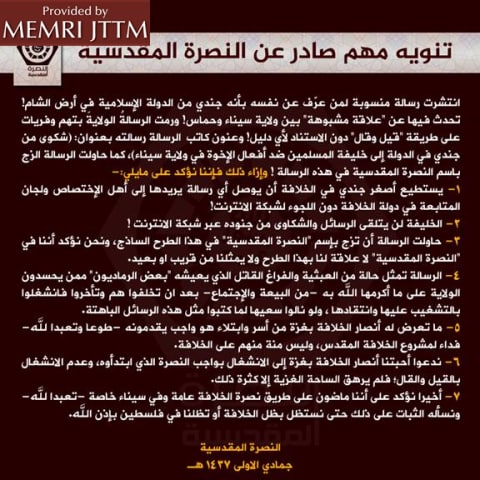
Al-Nusra Al-Maqdisisiyya’s clarification notice.
Endnotes:
[1] Telegram.me/jabal_1o0, February 29, 2016.
[2] ISIS rejects democracy and therefore uses the term pejoratively.
[3] Ra’ed Al-Attar was the commander of Hamas’ military wing in the southern district of the Gaza Strip, and was among the leaders of its weapons’ smuggling operations. He was killed by the IDF in August 2014.
[4] ‘Abd Al-Rahman Al-Nouri’s death in Syria was announced by pro-ISIS outlets online in July 2014. Paldf.net, July 7, 2014.
[5] Arafat Al-Sa’idi’s death in Syria was announced in May 2014 by the pro-ISIS forum Jihadi Media Platform and Twitter accounts associated with Gazan ISIS supporters. Al-Hayat (London), May 16, 2014.
[6] The phenomenon of members of Hamas’ military wing joining ISIS is a known one. The death of Abd Al-Ilah Qishta was a source for much confusion . The Egyptian army reported that it had killed Qishta in the Sinai, while other sources reported he had died fighting for ISIS in Libya. While some sources in his hometown of Rafah confirmed that he was a commander in Hamas’ military wing, his family denied that he had joined ISIS. Aljazeera.net, February 13, 2015; Raya.ps, February 11, 2015; Alwafd.org, February 11, 2015. Hamas officials denied he was a member of its military wing. Gazaalan.net, February 11, 2015.
[7] ISIS sources announced Muflih Abu ‘Adhira’s death February 15, 2016, without providing details about the circumstances in which he died. No Libyan sources claimed responsibility for killing him Twitter.com/Xog313/status/699392667814400000; Maannews.net, February 16, 2016.
[8] “Majlis Shoura Al-Mujahideen in the Environs of Jerusalem ” was a group formed by a merger of Salafi-jihadi factions operating in the Gaza Strip. Its establishment was announced in June 2012. In October 2012 the two leaders of the group were killed in an Israeli airstrike. See MEMRI JTTM report New Jihadi Group In Gaza Announces Its Establishment, Takes Responsibility For Attack In Southern Israel, Reveals Saudi And Egyptian Fighters Among Its Ranks, June 19, 2012. .
[9] For examples of ISIS campaigns calling on jihadis in various countries to join its ranks, see MEMRI JTTM report ISIS Launches Campaign Urging North African Muslims, Al-Qaeda Members To Join Its Rank, Target Local Governments, January 21, 2016; and MEMRI JTTM report ISIS Steps Up Efforts To Divide Somali Al-Qaeda Affiliate Al-Shabab, Calls On Its Members To Join ISIS’s Ranks, October 2, 2015.
[10] Abu ‘Abdallah appears to overlook ISIS’s widespread media campaign in which it lashed out at Hamas and encouraged Palestinians to continue escalating their wave of attacks. See MEMRI Inquiry & Analysis Series Report No. 1195, ISIS Campaign: Encouraging Palestinians To Carry Out Lone Wolf Attacks, October 20, 2015; Also, in July 2015 in July 2015 ISIS’s Aleppo branch released a video featuring three fighters from Gaza who vowed to take vengeance on Hamas. See MEMRI JTTM clip Palestinian ISIS Fighters in Aleppo Threaten Hamas: Gaza Shall Witness Blood and Torn Body Parts, July 2, 2015. For more on ISIS’s ambivalent relationship with the Palestinian issue and with its supporters in Palestine see: MEMRI Daily Brief no. 66, The Islamic State (ISIS) And Palestine – Rhetoric vs. Reality, November 19, 2015.
[11] Source: Telegram.me, Mu’assasat Al-Nusra Al-Maqdisiyya channel, February 27, 2016.





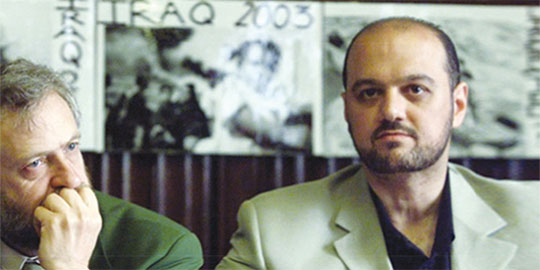 Anas Altikriti (right) with Jeremy Corbyn at an anti-war event in 2003: Altikriti has said that Iraqis had the right to expel the “occupation” (©Sean Dempsey/PA Archive/Press Association Images)
Anas Altikriti (right) with Jeremy Corbyn at an anti-war event in 2003: Altikriti has said that Iraqis had the right to expel the “occupation” (©Sean Dempsey/PA Archive/Press Association Images)




